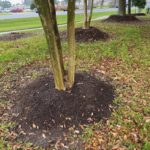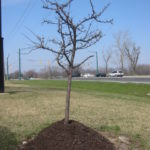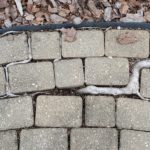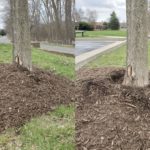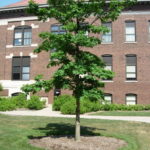Usage of mulch at the base of trees is a very common and recommended practice to protect the trunk from mower damage, as well as improve root conditions by preventing weed and grass growth in the root zone. Mulch also increases moisture retention in the soil, and improves soil quality as it breaks down over time. However, there is such a thing as “too much of a good thing.” Over-application of mulch, in the form of piles or “volcanoes” mounded up the trunk of a tree, will prove detrimental to the health of the tree and can lead to premature death (Figure 1, 2, 3). This is an unfortunate and fairly common occurrence in the landscape.
- Figure 1: Mature tree with mulch mounded onto the trunk (i.e. volcano mulch).
- Figure 2: Various tree species at a single site where too much mulch was applied. Photo Credit Lindsey Purcell
- Figure 3: A tree with a volcano of mulch piled against its trunk Photo Credit Lindsey Purcell
Plants are remarkably plastic organisms, meaning they have an incredible capacity to adapt to the environment and conditions around them (Figure 4). They have to because they cannot pick themselves up and find better climes. This is why you find them growing in weird situations or conformations. In light of that, plants have expected growth patterns: stems, trunks, leaves are above ground; roots are (mostly) below ground.
Roots belong underground. However, when too much mulch is applied (4-6 inches or more) and is in contact with the above ground trunk, you can effectively change the “perceived soil line” by the tree. This can trick some trees into developing roots directly out of the trunk that grow into the mulch which are more susceptible to drought stress than below ground roots. Thick mulch layers can also cause established roots to grow within the mulch layer above the soil and circle around in the tree. Roots that circle around the tree have the potential to grow into other roots (even the trunk flare) and girdle the vascular system of the tree, leading to stress and, under severe circumstances, early death.
Another issue with mulch in direct contact with the trunk is that the moisture it provides will cause the bark to become soft and eventually breakdown (Figure 5). Softened bark below the mulch is attractive to rodents, like mice and voles, which will lead to burrows, nesting and feeding injury, which can predispose the tree to infection by opportunistic pathogens that can rot wood.
- Figure 5: Left – Mulch applied improperly and unevenly to the base of a tree. Right – mulch pulled back to show some of the trunk flare.
- Figure 6: Properly applied mulch in the landscape.
Current recommendations for mulching include applying a 2-3-inch deep mulch layer to the ground from the trunk to a radius of 3-5 feet or larger. The trunk flare should still be visible and mulch should not be in direct contact with the bark; pull it back an inch or two (Figure 6).
The side-effects of volcano mulching occur slowly because it takes time for roots to grow and girdle, or decay to set in, or rodents to make a comfy home. Those misapplying mulch will likely blame tree decline on other problems. If you have been asked by a client to mound your organic matter or work on a crew that habitually creates miniature Mount Kilimanjaro’s with mulch, please spread the word to spread out the mulch.

